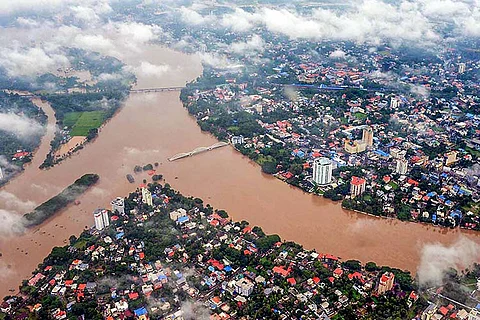

A year after being ravaged by the worst flood in 100 years, Kerala is once again facing a deluge. Over the past week, the state has been pounded by intense rainfall. The districts in Kerala’s north – in particular Kozhikode, Wayanad, and Malappuram –are among the worst affected.
According to the Indian Meteorological Department (IMD), Vadakara in Kozhikode recorded the highest rainfall in the state on Friday at 296 mm, Ottappalam in Palakkad received 286.2 mm, and Wayanad’s Vythiri witnessed 210 mm in a single day. The copious amounts of rainfall have been both intense and consistent this week alone.
Data from the IMD is revealing. If one were to look at Kerala’s rainfall this monsoon season beginning June 1 until August 7, the state has recorded a deficit of 27%, with 1078.6 mm rainfall against the normal of 1482.4 mm. But between August 1 and August 7, the state saw 22% excess rainfall. Seven districts have recorded excess rainfall over this week, with Palakkad recording a massive 80% departure from the normal. Malappuram, Kozhikode, Thrissur and Wayanad have also witnessed a sharp departure from the normal rainfall, with excess at 66%, 53%, 40% and 37% respectively.
TNM spoke to Venu G Nair, a meteorologist at the Centre for Earth Research and Environment Management to understand why Kerala is witnessing such extreme rainfall for two consecutive years.
Monsoon dynamics have changed
“Changes in monsoon started from 1960 onwards. We reached the threshold value in 2018,” explains Venu G Nair. Pointing out that the IMD normally categorises heavy rainfall as more than 115 mm and extreme rainfall as 200-250 mm, the meteorologist observes that the Western Ghats region received 350 mm of rainfall intermittently in June, July and August of 2018, eventually resulting in heavy flooding.
He says, “This time it’s the reverse. There were drought conditions. Never before in the history of Kerala has there been no rain in June. There was some rain in July, but the extreme rainfall began a few days ago.”
Venu G Nair suggests two primary factors for Kerala receiving extreme rainfalls this week.
Typhoons in Western Pacific
There are twin typhoons, which are 2000 metres apart in the Western Pacific Ocean, that are resulting in mayhem in Kerala. While Typhoon Lekima made landfall early Saturday morning between Taiwan and China’s financial capital Shanghai, another storm Krosa is heading towards Japan and is likely to hit early next week.
“The pattern of the monsoon winds (in India) is such that it is feeding these two monster typhoons,” says Venu Nair, adding that the air is being pulled in such a manner that it is resulting in very heavy downpour for Kerala.
‘Pacific Ocean the culprit’
The meteorologist goes on to observe that the influence of the Western Pacific Ocean, which was limited earlier, is now increasing in the Indian domain.
“The Pacific Ocean is using the Indian Ocean as a dump yard, resulting in the south Indian ocean becoming a hotspot,” he explains. In layperson's terms, this means that the surface temperature of the Pacific Ocean is decreasing as it transfers or ‘dumps’ the heat in the Indian Ocean.
As a consequence, this is changing the pattern of the southwest monsoon in India. Venu Nair explains that the Somali Jet Stream (which is made of temporary winds) that plays a crucial role in the formation and progression of the southwest monsoon has been modified by the Indian Ocean.
Will this change in the Indian Ocean return to normal? The meteorologist says, “In my opinion, it won’t happen. There has been a global change in the ocean since the 1970s and we cannot do anything. An Intergovernmental Panel on Climate Change (IPCC) report states that all tropical countries will lose their boundaries because of flooding, owing to the warming of oceans.”
He warns, “Global warming is a reality. It has affected the tropical region heavily and it has to be investigated. Otherwise, when it does rain it will be an extreme event.” The only way forward now, he says, is to cut down carbon emissions globally.
And while extreme rainfall is just one reason for the flooding in Kerala, other experts point to development and infrastructure projects, which have altered the state’s hydrology by not allowing the water to percolate to the ground. This in addition to Kerala’s topography and its narrow rivers, which are now in spate, have exacerbated the natural disaster in the state for the second consecutive year.